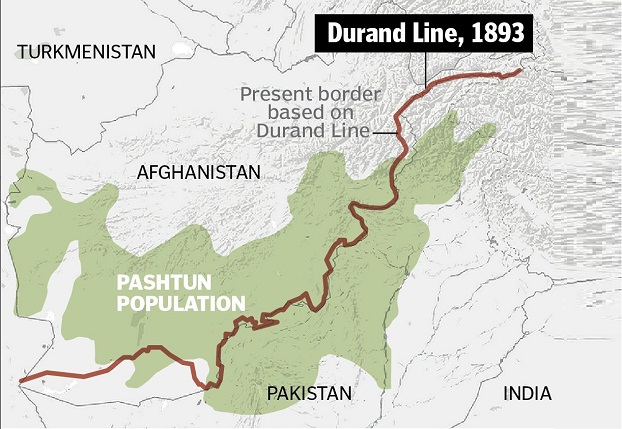By Noor Ahmad Khalidi and Translated by Mujeeb R. Awrang
Historic Background
When, Mountstuart Elphinstone, the British (British India) representative came to the winter capital of Shah Shuja in Peshawar in 1809 to sign a deal with him to prevent the possible aggression of Napoleon, the territory of Kabul kingdom was prolonging till Kashmir, Punjab, and Sindh. (Mounstuart Elphistone, Kabul Kingdom report, and its attachments in India, Tartary, and Persia). The Afghan government then was considered as a threat to the British Colonial’s extensions in the Indian Sub-Continent.
It is worth mentioning that the Indian Maharajas (kings) in the latest years of 18 century called on the Afghan King Zaman Shah to help them to pushback British Colonial from India. They also offered readiness to pay for the expenses of the Afghan forces. (Refer to the book of Mahmood Mahmoodi, the political relations between British and Iran in 19 century, published in Tehran). Therefore, to undermine the Afghan government and to prevent the Afghans from helping the Indian people against the British, the British colonial supported Ranjit Singh in Punjab (an Indian northwest state) to remain as an obstacle between Afghanistan and India. The existence of this obstacle paved the ground for the British to bring all areas in South of India initially under its control and then eliminate this obstacle- which both enemies wanted to be removed- and place itself (British) before a feeble government in Kabul.
Thus, in the wake of Ranjit Singh’s armed attacks from 1818-1838- following by the British attacks and during several wars including the first Afghan-British war in 1838-1842 and the second Afghan-British war in 1879-1882, the areas and territory related to Afghanistan on both sides of the Sindh River were separated from Afghanistan because of armed threats (by British) and compulsory deals such as (Jamrud deal in 1855 in Emir Dost Mohammad Khan) followed by (Gandamak deal in 1879 with Emir Yaqob Khan). (In this regard, it is worth mentioning that the trilateral deal of Jun 26, 1838, among Shah Shuja, Ranjit Singh, and British in Lahore and his agreement to submit the Afghanistan territory to Ranjit Singh is invalid because he was not the active emir or king of Afghanistan then, and he signed the agreement as a feoffee of Sadozai family, not as a king of Afghanistan.)
Durand Line Pact
1- Reason for signing the deal
After the second Afghan-British war in 1882, many areas from Chitral in North to Chaman in South were invaded by the aggressive army of British, but the areas were not legitimately part of British India (British Raj) territory. As the influential zones between the Afghan government and British Raj were unclear- and to prevent the controversies-the Durand deal was signed between emir Abdul Rahman Khan and Sir Mortimer Durand, the foreign minister of British Raj on 12 of November 1893 in Kabul. Based on the imposed deal of Gandamak in 1879, the foreign policy of Afghanistan was under the protection of the British Raj.
2- Purpose of Durand Deal
The Durand deal determines the influential zones (limit) of the two governments on the tribes living alongside the west of Sindh River from Chitral to Baluchistan.
Although these areas were out of the Afghan government’s control as a result of consecutive attacks by Ranjit Singh, they were not legitimately recognized as part of the British Raj territory (1935).
The bordering state of the northwest was formed in 1849 and based on the Durand deal the free tribal areas (Chitral, Swat, Bajaur, Khaiber, Kurram, and Waziristan) which remained undelineated since 1893 as the fenders between the territory of British Raj and the Afghan government, become under the influence of British Raj but not included or recognized as part of British Raj territory.
The question is that is the Durand line a recognized-border between Afghanistan and Pakistan?
Based on the documents from British sources the Durand deal was not signed to determine the borderline between Afghanistan and the British Raj but it was set to determine the limit of influence of the two sides on the people of tribal areas settled in the west of Sindh River, and most of this region is still known as “Tribal Areas”.
Most importantly, Sir Mortimer Durand himself who was the British Raj foreign minister in 1893-signed the Durand deal with Abdul Rahman Khan- the deal is also known after his name- confirms in an interview in 1897 with Asiatic Quarterly Journal as saying “the tribes settled in Indian side should not be included in British Raj territory, as they are only related to the emir, they are (technically) under our influence and that is as far as they are ready to accept British India’s influence or we impose this influence on them.”
The Britain Asiatic Quarterly writes that “the Durand Line of 1893 divided zones of responsibility for the maintenance of law and order between British India and the kingdom of Afghanistan; it was never intended as a de jure international boundary.”
3- Durand Deal Deadline
Based on the British government interaction, the deals between the Afghan emirs and British India are considered as individual deals and all of them declared invalid after the deaths of the emirs. For this purpose, if British India sought the extension of the deal on its interests, it needed the official commitment of the emir. Therefore, British India acquired the commitment of emir Habibullah Khan regarding the Durand Deal after-his father- Abdul Rahman Khan died in 1905. The deal was also reconfirmed by emir Amanullah Khan on August 8th 1919 deal of Rawalpindi. Under August 1919, the previous deals signed between Afghan emirs and British India were declared invalid. The British also declared Afghanistan’s independence in interior and foreign affairs.
Emir Habibullah Khan in 1905 reaffirmed the deal that his father signed with British India. The agreement included the “prolonging of the deal between emir Abdul Rahman Khan and British India” and its second paragraph indicated that “I acted, I am acting, and will act in accordance to this deal and will not oppose in any deal with them (British).” Following his father’s (Habibullah Khan) death, Emir Amanullah Khan reconfirmed reiterated Habibullah Khan’s commitment in a ceasefire deal signed between Afghanistan and British India on 8 August 1919.
But in accordance to the written documents of Alfred Hamilton Grant Foreign Secretary of the Government of British India from 1914 to 1919 –which was written as the second attachments of the deal- officially titled by Ali Ahmad Khan, head of the Afghan delegation- all previous deals between the former Afghan emirs and British India are canceled.
4- Rawalpindi deal of August 8th, 1919
The Rawalpindi agreement was originally a temporary deal that was set to conclude a friendship deal between the two sides in Kabul. However, the head of the Afghan delegation initially agrees on the context of the deal, he, later on, argues that there was no hint to Afghanistan’s independence in the draft. In response to him, Hamilton Grant Foreign Secretary of the Government of British India and head of the British delegation-in a written draft of Ali Ahmad Khan-which was officially put on as a second attachment to the deal- confirmed the bellow materials which are mentioned in the ceasefire agreement of August 8th, 1919.
– British recognize Afghanistan’s independence in interior and foreign affairs.
– British financial support to Afghanistan is terminated.
– All previous deals between the emirs (Amir) and British India are canceled.
– The import of weapons via India is forbidden.
Foreign Secretary of the Government of India, Alfred Hamilton was head of the British delegation in the peace negotiations of Rawalpindi. The Afghan delegation led by Ali Ahmad Khan (Emir Amanullah Khan’s cousin). Some analysts including Louis Dupree believe that Grant – as a successful diplomat- was able to gain more leverage in the negotiations from the Afghan delegation. The Pashtuns on the west side of the Sindh River were not satisfied with this deal. It is said that Amanullah Khan was not pleased with the results of the negotiations, thus, he dismissed Ali Ahman Khan and asked his father-in-law to the responsibility for the negotiations. Ali Ahmad Khan faced a terrible destination and was executed by Habibullah Kalakani.
The fifth principle of the Rawalpindi deal concluded the reconfirmation of the Durand line. (Historical Dictionary of Afghanistan, p 465, Ludwig W. Adamec). It is worth mentioning that the deal was signed under serious pressure by British India.
The British threats were as bellow:
– Invasion of Jalalabad
– Preserving Afghanistan’s foreign policy under its protection
– Blocking the transit paths to Afghanistan
– Accepting British as the prior and preferred country in foreign relations
5- Mysore Conference from 17 April to 18 July 1920
The Rawalpindi deal was generally a temporary agreement and didn’t resolve the entire dispute between the sides. In fact, to reach a breakthrough on this issue, a conference was held in Mysore between the Afghan delegation, led by the foreign minister, Mahmood Tarzi, and the British Indian government. The sides failed to reach a breakthrough on the disputed issues.
The tribes on the other side of the Durand Line didn’t accept the August 1919 deal of ceasefire and waited to restart fighting if the British denied meeting the demands of the Afghan government.
6- Kabul deal of 1921 between British-Afghanistan
The treaty of 22 November 1921 signed between Afghanistan and British India (Afghan Treaty-Anglo of 1921) is the first deal concluded between the Afghan government and British India. Prior to that, all agreements were signed between the Afghan emirs and British India as individual deals, not as official agreements with the Afghan government, and therefore, all the previous treaties are considered individual-deals that are declared invalid after their deaths.
The reason for this policy was that the British sought to not stick itself to any previous deal and gain more leverage with the each-new emir taking the kingdom.
The second principle of the 1921 Kabul treaty confirms the fifth principle of the Rawalpindi deal. But based on the 14th principle, the mentioned treaty was temporary valid for three years, and “therefore, this treaty included a clause which gave either of the “High Contracting Parties” the right to unilaterally denounce the Treaty after giving one year’s notice.” For the same purpose, Lord Birkenhead in a memorandum circulated in June 1925 assessed the same when he mentioned that “the treaty was made for three years in the first instance, and is now subject to denunciation by either party with 12 months’ notice.”
To be concluded
 Afghanistan Times
Afghanistan Times




